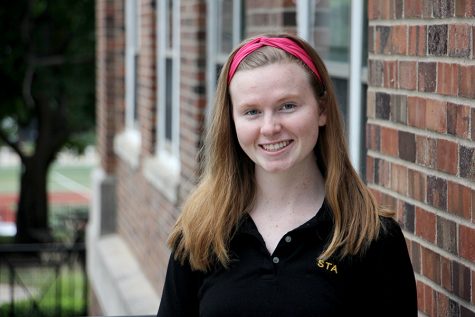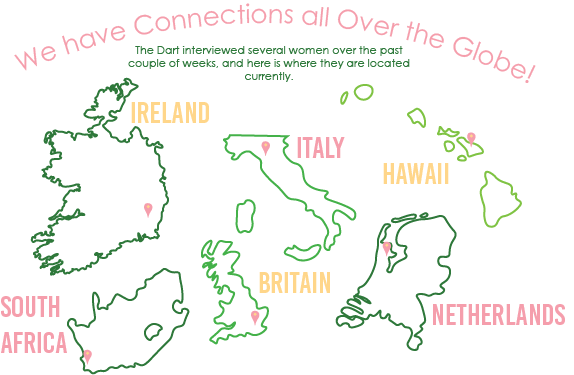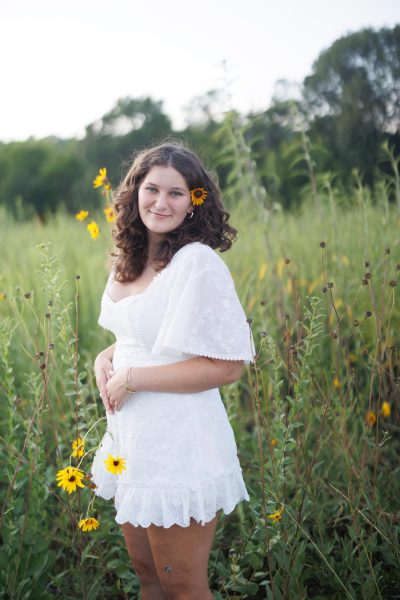Career consultations
The Dart explores different opportunities STA offers for career exploration.
October 12, 2015
As she walks down the steps in the Goppert Center, she chats with a senior cross country team member about a recent injury.
“I can barely walk down the steps,” the runner said. “It must be because of practice yesterday.”
She looks concerned, asks the girl about where the pain is, and tells the runner to “get some stretches in” before she does any more practice.
She isn’t a cross country coach or any member of the STA athletic staff. She is senior Sarah Mitchell, and she is currently shadowing with STA’s physical trainer Lisa Gross to explore a career in the sports medicine field. Their mentor/mentee relationship is the first of its kind at STA, but according to Gross, she would “absolutely” look into doing more programs like it further down the road.
Mitchell comes in after school from 3 p.m. until around 6 p.m., Tuesdays through Thursdays, as well as during any home games. She assists Gross with basic tasks around the training room, ranging from finding disposable cups to checking patients in to basic wound care. Gross says that not only is Mitchell eliminating some of her stress, acting as “an extra pair of hands or legs” during busy times, but she is also getting an experience pretty close to what a real sports medicine career would be as far as the tasks she’s completing.
“There’s just a wide spectrum between simple, basic responsibilities and really serious, potentially catastrophic situations that you will be in charge of and expected to manage in that moment,” Gross said.
For Mitchell, covering the bases of different tasks has been a “great learning experience,” giving her an opportunity to learn more about the field in a more comfortable setting where she is “treating [her] friends”. Mitchell says shadowing Gross looks like “exactly what [she wants] to do” later in life.
Mitchell also says she has “gotten a lot out of” shadowing Gross and watching her help the different athletes.
“I am inspired by Lisa a lot because she chose to work at this school and she’s worked with all sorts of athletes, but it really does inspire me to see her in her position,” Mitchell said.
While Gross and Mitchell have a unique mentor/mentee relationship, the training room isn’t the only place at STA where mentoring is happening. Academic counselor Kathy Brodie is head of the eMentoring program at STA, a program in which an STA junior is paired with a professional in a field they are interested in. Brodie introduces a mentor to a student via email to answer questions “provide advice and support about their profession,” according to Brodie.
The eMentoring program particularly emphasizes connecting the student with a woman in her field. Rather than just “reaching out blind,” Brodie says she looks first for STA alumnae, then for women who have connections to STA.
“There are so many [alumnae] that want to do something for St. Teresa’s that I always reach out to them, because it’s a way they can do something without affecting their schedule,” Brodie said. “It gives them a way to give back to the community that fits their life.”
Senior Kristina Coppinger believes that STA utilizing female mentors is especially helpful at an all girl’s school like STA.
“I do believe there is a specific, intangible value and relatability in having the mentor be female,” Coppinger said. “In a male-dominated field, such as engineering, it was more relevant [for me] to get advice and expectations from a woman.”
Because the program is online, students are not limited to mentors around the Kansas City area. According to Brodie, many of the mentors in the program are from all across the country. A student may be paired with up to three or four mentors throughout the course of the year, all over email. Brodie says that having the exchanges done over email make for a “pleasant exchange” that won’t add a lot of stress to a student or mentor’s life.
“It is a responsibility that adds on to their workload and that’s why we try to keep it as simple as possible,” Brodie said. “The more involved you get, the longer it takes.”
If an exchange goes well and a student is serious about considering that profession, rather than “just exploring,” some students have both continued emailing for many exchanges or schedule a job shadowing date, but it depends on “how interested” each student is.
Coppinger describes the eMentoring program as “extremely helpful” in helping her get a feel for the engineering field.
“My mentor was perfect for me,” Coppinger said. “We talked about college in general, my hobbies, what I want to do with my life and things like that. She always responded with great advice and insightful comments regarding my aspirations to be an engineer.”
For a professional to become a mentor, it takes “very minimal training” done over email. Brodie says she does not have to look hard to find contacts for mentors because many of the alums are eager to do what they can to help STA. While there are many contacts for most fields, Brodie says she is still looking for female mentors in the fields of theater and performance and editing and film.
The eMentoring program may have a long list of prospective mentors in most fields, but the third main mentoring opportunity offered at STA was founded for the opposite reason, according to principal of academic affairs Barbara McCormick.
This year, STA is offering a STEM mentoring class for around 10 juniors and seniors. Unlike most science classes at STA, however, the STEM program takes place entirely outside of school. It is run through KCPT and puts STA students in contact with engineers from Black & Veatch, an engineering firm in Kansas City, collaborating to introduce engineering ideas to fifth graders at different schools across Kansas City.
According to McCormick, in past years, the engineers faced difficulties with managing all the different projects at each school.
“Some of the problems [the engineers] faced were that some of these student groups were large, like around 80 students,” McCormick said. “These engineers aren’t trained to be teachers and so classroom management was hard for all these project-based activities.”
To offer a solution to the engineers’ problem, a Black & Veatch employee and STA father Joe Rose contacted McCormick about involving STA students in the different projects, according to McCormick.
“So [the KCPT correspondent for the project] Gary Brock and Joe Rose and I started this conversation about if it would be helpful for our students to not only be mentored by the engineers but to be mentors to the 5th graders, and they thought that was a fabulous idea,” McCormick said.
Each student involved will miss around six half-days of school, according to McCormick. Two or three girls will go to assigned public grade schools around Kansas City for three weeks in a row, before switching to their second and final school group. According to McCormick, each visit to each school has a different theme.
“The first [visit] is an introductory session, where they explain the acronym of STEM, what it’s about, and then probably some tower-building and construction work,” McCormick said. “Then they go back the next week. They go to the same schools for 3 weeks in a row, about an hour. The next session is then about circuits and the last one is a water cycle.”
During each school visit, students will be setting up the space, cleaning up, and answering questions. According to McCormick, while the STA students are being mentored, they are also instructed to act as mentors themselves when helping the fifth graders.
“They’re going to take their leads from the engineers as they explain the projects to the larger student bodies, and then they’re going to walk around,” McCormick said. “Their job is not to solve the problem for [the younger students], but to get them thinking more deeply.”
Senior Meredith Raymer is participating in the class, and while she feels nervous about missing so much school, she is also looking forward to being mentored by an engineer in the field.
“I’m really excited about it because I haven’t investigated engineering as field until about three months ago and now, I’m more interested in it,” Raymer said. “It’s a good way to get real life [experience], to get to talk to people in the field, to hear what they do and what interested them in the first place.”
Raymer believes many of the STA girls participating are not only interested in being mentored, but in being mentors to the younger kids.
“[I think] we are interested in the service component of it — helping students see engineering and other stem careers as a future,” Raymer said. It’s not something a lot of people see in everyday life. Everybody knows you can use science and you can become a doctor but seeing engineering especially is not something a person, especially a fifth grader sees as a possible career.”
McCormick believes that a major benefit of the STEM mentor program will be the community and service involvement.
“I also think it’s a great way for us to speak to the community with our students, saying ‘We’re about STEM, we see STEM as a great opportunity… just trying to get STA more connected with what’s around us.”
While McCormick knows that the STEM mentoring, eMentoring and job shadowing programs all take time, she encourages students to take advantage of the opportunities they are presented.
“I know the girls are very worried,” McCormick said. “I’m hoping we can relieve their fears by showing them that this is a good opportunity [for them] and that sometimes you have to sacrifice seat time in a classroom to do something that is valuable.”








